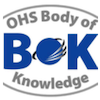Chapter 17.4: Process Hazards - Chemical
Abstract
Chemical process hazards may be associated with high-consequence outcomes of fire, explosion and/or release of toxic substances. While the management of such hazards is usually the responsibility of those with specialist process safety or chemical expertise, generalist occupational health and safety (OHS) professionals should understand the basic science underpinning the characteristics of such hazards, the mechanisms by which they cause harm, potential consequences – fire, explosion and toxic effect – and common controls. As a companion chapter to OHS Body of Knowledge 12.3 Managing Process Safety, and with reference to the Globally Harmonised System (GHS) of Classification of Labelling of Chemicals, this chapter provides information vital for understanding and applying process safety management strategies. Such knowledge will enable generalist OHS professionals to effectively engage with process safety and chemical safety experts, contribute to better hazard control and reduce the risk of catastrophic events.
Keywords: process safety, hazardous substances, chemical, fire, explosion, toxic release, GHS, barrier
First year of publication: 2017
Current Version: 2019
Chapter 17.4: Process Hazards - Chemical
Table of contents
| 1 | Introduction |
| 1.1 | Process for developing the chapter content |
| 2 | Historical perspective |
| 3 | Extent of the problem |
| 4 | Underpinning science |
| 5 | Chemical process hazards |
| 5.1 | Hazardous substances |
| 5.2 | Sources of ignition |
| 5.3 | Operating temperatures |
| 6 | Consequences |
| 6.1 | Fires |
| 6.2 | Explosions |
| 6.3 | Toxic effects |
| 7 | Legislation and standards |
| 8 | Control |
| 8.1 | Layers of protection |
| 8.2 | Barriers |
| 8.3 | Elimination |
| 8.4 | Prevention |
| 8.5 | Mitigation |
| 9 | Implications for OHS practice |
| 10 | Summary |
Useful resources
References
Purchase the AUDIO chapter here through AIHS
OR

Trish Kerin BEng(Mech)(Hons), DipOHS, GAICD, CEng, FIChemE,
Professional Process Safety Engineer, FIEAust Director, IChemE Safety Centre, Institution of Chemical Engineers
After graduating with honours in mechanical engineering, Trish spent several years working in project management, operational and safety roles for the oil, gas and chemical industries. Trish has represented industry on many government committees related to process safety, and currently sits on the board of the National Offshore Petroleum Safety and Environmental Management Authority (NOPSEMA) and the Mary Kay O’Connor Process Safety Center steering committee. Trish leads the IChemE Safety Centre, a not-for-profit industry-led consortium focused on improving process safety.
Learning Outcomes: Process hazards (Chemical)
The OHS Body of Knowledge takes a conceptual approach which enables it to be applied in different contexts and frameworks.
To optimise its value for education and professional development learning outcomes have been developed for each technical chapter in the Body of Knowledge.
The learning outcomes as described give an indication of what should be the capabilities of an OHS professional; it is up to those developing OHS education programs, OHS professionals planning their CPD or recruiters or employers selecting or developing people for the OHS function to consider the required breadth vs. depth .
Please read the section on using the learning outcomes before delving into the leaning outcomes of the individual chapters.
The numbers against each learning outcome refer to the chapter number of the BOK download page. No learning outcomes have been developed for the chapters considered introductory or underpinning knowledge (that is chapters 1, 2, 3, 4, 5, 6, 7, 1, .13, 14, 15.)
Published 2017 Chapter 18.3 Process Hazards

